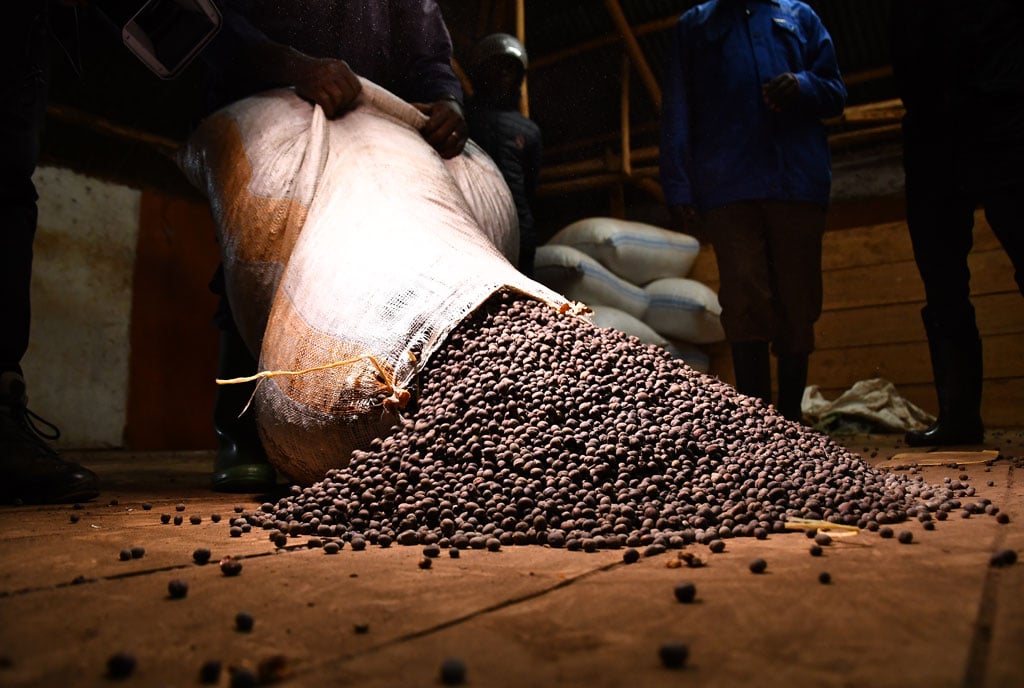
Dr.Rogers Ruyonga (left), Private Secretary for Ventrinary Affairs, State House and students of Makerere University, college of Veterinary medicine vaccinate a dog against rabies in Kyanja, Nakawa
division, Kampala. PHOTO BY ALEX ESAGALA.
The rising cases of stray dog bites and the risk of spreading rabies in Kampala have forced the city authorities to sterilise dogs to cut down the number of stray canines.
The acting district veterinary officer, Dr Herbert Kasiita, said recent data shows there are 6,000 stray dogs, with another 2,000 dogs with owners who do not take care of them.
“Last year the stray dog population in Kampala was 6,000. This year I am sure it is higher. I cannot give you the exact number, but it is higher than 6,000. The owned dogs were 12,000,’’ he said.
Dr Kasiita said the ever-swelling number of stray dogs has become a pressing challenge in Uganda’s capital city, Kampala, and the country as a whole.
He added that in the space of just five years, between 2015 and 2020, the country recorded 14,865 dog bites and 36 dog-bite-related deaths. In May 2023, Dr Hannington Katumba, a veterinarian at Kampala Capital City Authority (KCCA), said they recorded between 15 and 20 dog bites monthly.
Rabies, a deadly viral disease, spreads to people and animals via saliva, usually through bites, scratches or direct contact with mucosa, including mouth or open wounds. Dogs are the main source of human rabies deaths, contributing up to 99 percent of all rabies transmissions to humans.
The World Health Organisation (WHO) says rabies is a vaccine-preventable viral disease that occurs in more than 150 countries and territories. The UN health agency says rabies causes tens of thousands of deaths every year, mainly in Asia and Africa, with 40 percent of the cases affecting children under 15 years of age.
Dr Kasiita defined a stray dog as an owned dog that has lost its home. He said such dogs are common in marketplaces, abattoirs, and places where meat is roasted.
Dr Kasiita also said such stray dogs were once owned pets, but some venture out during mating seasons and never return home, becoming strays. He said others, driven out by hunger, seek food in markets and trading centres, finding better sustenance than what they receive at home.
The vet said this cycle contributes to the increasing population of stray dogs that now roam the streets of Kampala, posing a threat to public health and safety.
Dr Kasiita warned of the grave danger of rabies, a viral disease transmitted through dog bites, saying 99 percent of rabies cases in Uganda originate from dogs. He said once the signs of rabies start to show, one cannot recover because rabies is fatal.
Dr Kasiita said Kampala Capital City Authorities (KCCA) has so far carried out 100 surgeries on such dogs through community clinics in its five divisions and plans to do more. He said their goal is to vaccinate 5,000 dogs and perform surgeries on 600 dogs in Kampala alone.
Dr Kasiita said KCCA was working with the Uganda Small Animal Practitioners Associations, and Makerere University, and other institutions.
“We do spaying and neutering, meaning the females will have their reproductive organs removed to stop them from giving birth and neuter the males or remove their reproductive organs to stop them from reproducing,” he said.
Dr Kasiita also said the sterilisation would extend beyond Kampala, with clinics planned for Wakiso, Rakai, and Mbale districts. He urged other districts to join the fight against rabies and stray dog populations.
Dr Kasiita asked dog owners to take responsibility for their pets, restrain them and provide care, and prevent them from becoming strays. He also urged the public to report stray dogs to the authorities for swift action.
Dr Kasiita said timely medical treatment for dog bites and using post-exposure prophylaxis were vital measures. Previously, he said, KCCA was eliminating stray dogs through poisoning, but said animal rights activists have forced this to stop.
Dr Kasiita said KCCA has several challenges in harmonising data from dog bites because people rarely report the cases for fear of stigma while many more do not know where to report their concerns.
Kampala receives numerous complaints about stray dogs, but the reports come through various channels, including from the town clerks’ offices to direct submissions to the veterinary authorities.
KCCA efforts so far
Dr Kasiita, says: “Stray dogs in Kampala not only pose a risk of bites and rabies but also instill fear in residents. People avoid areas where packs of dogs congregate, affecting daily life and even school attendance, particularly for children who encounter these packs on their way to school.”
Previously, he said, KCCA was eliminating stray dogs through poisoning, but said animal rights activists have forced this to stop.
“Because of the inhumane way that medicine or drugs are used to kill the animals, we no longer do that. So this method that we are using is a slow one, but if we can multiply the efforts, I’m sure it will get us there,” he said.
He also said: “If we can achieve 70 percent vaccination of all the dog population that will protect our dogs from rabies. And once the dogs are protected from rabies, we humans are also protected because we get our rabies from the dogs.’’
Dr Kasiita said community engagement is key in the battle against stray dogs. He singled out ongoing efforts, including monthly free community vaccinations. Partnerships with organizations like Unique Repose, USPCA, and Uganda Small Animal Practitioners Association that enable these campaigns. The goal is to vaccinate 5,000 dogs and perform surgeries on 600 dogs in Kampala alone.
KCCA also uses the KCCA livestock ordinance of 2006 to punish careless pet owners but implementation has been slow. The Ordinance states that pet owners are to pay two currency points; an equivalent of Shs40,000, or suffer imprisonment or even both, depending on the damage. This ordinance also requires that pet owners to have their pets registered with KCCA for proper planning.
KCCA also works with the Uganda Society of Protection for Animals (USPCA) an organisation that rescues animals from those harassing them and also the stray animals.
Our efforts to speak to the organization authorities on the number of stray dogs rescued were futile by press time.
Rabies and treatment
Dogs are the main source of human rabies deaths, contributing up to 99 percent of all rabies transmissions to humans.
Rabies can be prevented through the vaccination of dogs and the prevention of dog bites. After exposure of people to a potentially rabid animal, they should seek post-exposure prophylaxis (PEP), which consists of immediate, thorough wound washing.
Globally rabies causes an estimated cost of US$ 8.6 billion per year.
A One-health approach assures the engagement of multiple sectors and local communities to build awareness and conduct mass dog vaccination campaigns.
Rabies is a vaccine-preventable, zoonotic, viral disease affecting the central nervous system. Once clinical symptoms appear, rabies is virtually 100 percent fatal. In up to 99 percent of cases, domestic dogs are responsible for rabies virus transmission to humans. Yet, rabies can affect both domestic and wild animals.
Rabies is present on all continents except Antarctica, with more than 95 percent of human deaths occurring in Asia and Africa. However, rabies cases are rarely reported and registered numbers differ greatly from the estimated burden.
Rabies is also one of the neglected tropical diseases (NTD) that predominantly affect already marginalised, poor and vulnerable populations.
Cost of treating rabies
Although effective human vaccines and immunoglobulin exist for rabies, these are often not readily available or accessible to those in need. Managing a rabies exposure, where the average cost of rabies post-exposure prophylaxis (PEP) is currently estimated at an average of US$ 108 (along with travel costs and loss of income) can be a catastrophic financial burden on affected families whose average daily income may be as low as $ 1–2 per person.
Every year, more than 29 million people worldwide receive PEP. This is estimated to prevent hundreds of thousands of rabies deaths annually.
Globally, the economic burden of dog-mediated rabies is estimated at $ 8.6 billion per year, in addition to incalculable psychological trauma for individuals and communities.
How sterilisation is done
Castrating a dog
Small Door Veterinary, a US organisation that delivers superior veterinary care for pets, says neutering, also known as castration, is a surgical procedure performed by a veterinarian to remove the testicles.
It is a less invasive procedure than spaying or “fixing” equivalent for female dogs.
Unlike the ovarian and uterine structures, which are located in the abdomen, the testicles in male dogs are located outside, within the scrotum.
The dog is put under general anesthesia and the veterinarians make a single incision in the skin of the scrotum to remove the testicles. Sometimes one or both of the testicles will not descend and instead remain located in the abdomen.
In these cases, an abdominal exploratory surgery will be necessary, as testicles that remain in the abdomen can become cancerous.
Neutering a dog helps eliminate the risk of unwanted puppies.
There are also several other important advantages to neutering your dog, namely No risk of testicular cancer, significantly reduced risk of prostate disease and perianal tumors, decrease in unwanted urination behavior, decrease in roaming behavior, and less aggression.
Spaying a dog
Spaying, or “fixing,” a dog is a surgical procedure that removes all or some of the reproductive organs in a female dog.
There are two types of sterilisation procedures in dogs, namely ovariectomy and ovariohysterectomy. An ovariectomy removes only the ovaries, while an ovariohysterectomy, commonly known as a spay, removes both the uterus and ovaries.
Both procedures eliminate a female dog’s ability to go into heat and to reproduce.
A spay operation requires full anaesthesia
One a dog has been placed under anaesthesia, a breathing tube will be used to help deliver oxygen to the dog’s lungs during the surgery.
The veterinarian then makes an incision in the dog’s abdomen that’s long enough for to locate the reproductive organs. The vets then remove the ovaries and uterus through this incision, or just the ovaries, depending on whether the vet is performing an ovariectomy or ovariohysterectomy, and stitch the incision.
Once complete, the dog will no longer be able to have puppies, and the procedure is not reversible.
Source: Neutering a Dog: Everything You Need to Know | Small Door Veterinary






